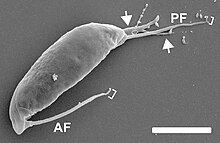Apusomonadidae
| Apusomonadidae | |
|---|---|

| |
pseudopodium . Scale bar = 5 μm.
| |
| Scientific classification | |
| Domain: | Eukaryota |
| Clade: | Amorphea |
| Clade: | Obazoa |
| Class: | Thecomonadea Cavalier-Smith, 1993 emend. 2013[2] |
| Order: | Apusomonadida Karpov & Mylnikov, 1989[1] |
| Family: | Apusomonadidae Karpov & Mylnikov, 1989[1] |
| Genera | |
|
See text | |
| Diversity | |
| 28 species | |
The apusomonads (family Apusomonadidae) are a group of protozoan zooflagellates that glide on surfaces, and mostly consume prokaryotes. They are of particular evolutionary interest because they appear to be the sister group to the Opisthokonts, the clade that includes both animals and fungi. Together with the Breviatea, these form the Obazoa clade.[3][4][5]
Characteristics
Apusomonads are small
- Derived cell plan, represented by Apusomonas, with a round cell body and a mastigophore, a projection of the cell containing both basal bodies at its end.[6]
- "Amastigomonas-like" cell plan, with an oval or oblong cell that generally forms
Evolution
External relationships
The apusomonads are the sister group to
Apusomonads are vital to understanding
Internal relationships
Apusomonads are a poorly and narrowly studied group.
Apusomonadida
|
|
"Amastigomonas-like" organisms | ||||||||||||||||||||||||||||||||||||||||||||||||
Taxonomy
History
Apusomonads were first described in 1989 as one
Classification
There are 10 recognized genera, as well as the "Amastigomonas-like" archetype that includes primitive forms not yet transferred to new genera.[7]
- Amastigomonas de Saedeleer 1931
- A. caudata Mylnikov 1989 [Amastigomonas borokensis Hamar 1979]
- A. debruynei de Saedeleer 1931
- A. marisrubri Mylnikov & Mylnikov 2012
- Catacumbia Torruella, Galindo et al. 2022[7]
- C. lutetiensis Torruella, Galindo et al. 2022
- Cavaliersmithia Torruella, Galindo et al. 2022
- C. chaoae Torruella, Galindo et al. 2022
- MultimonasCavalier-Smith 2010
- M. koreensis Heiss, Lee, Ishida & Simpson, 2015
- M. marina (Mylnikov 1989) Cavalier-Smith 2010 [Cercomonas marina Mylnikov 1989; Amastigomonas marina (Mylnikov 1989) Mylnikov 1999]
- M. media Cavalier-Smith 2010
- Mylnikovia Torruella, Galindo et al. 2022
- M. oxoniensis (Cavalier-Smith 2010) Torruella, Galindo et al. 2022 [Thecamonas oxoniensis Cavalier-Smith 2010]
- Podomonas Cavalier-Smith 2010
- P. capensis Cavalier-Smith 2010
- P. gigantea (Mylnikov 1999) [Amastigomonas gigantea Mylnikov 1999]
- P. griebenis (Mylnikov 1999) [Amastigomonas griebenis Mylnikov 1999]
- P. kaiyoae Yabuki in Yabuki, Tame & Mizuno 2022[11]
- P. klosteris (Arndt & Mylnikov 1999) Cavalier-Smith 2010 [Amastigomonas klosteris Arndt & Mylnikov 1999]
- P. magna Cavalier-Smith 2010
- Apusomonadinae Cavalier-Smith 2010[3]
- RostromonasKarpoff & Zhukov 1980]
- A. australiensis Ekelund & Patterson 1997
- A. proboscidea Alexeieff 1924 [Rostromonas applanata Karpoff & Zhukov 1980]
- ManchomonasCavalier-Smith 2010
- M. bermudensis (Molina & Nerad 1991) Cavalier-Smith 2010 [Amastigomonas bermudensis Molina & Nerad 1991]
- Thecamonadinae Larsen & Patterson 1990 [Thecamonas/Chelomonas clade]
- Chelonemonas Heiss, Lee, Ishida & Simpson, 2015
- C. dolani Torruella, Galindo et al. 2022
- C. geobuk Heiss, Lee, Ishida & Simpson, 2015
- C. masanensis Heiss, Lee, Ishida & Simpson, 2015
- Karpovia Torruella, Galindo et al. 2022
- K. croatica Torruella, Galindo et al. 2022
- Singekia Torruella, Galindo et al. 2022
- S. franciliensis Torruella, Galindo et al. 2022
- S. montserratensis Torruella, Galindo et al. 2022
- ThecamonasLarsen & Patterson 1990
- T. filosa Larsen & Patterson 1990 [Amastigomonas filosa (Larsen & Patterson 1990) Molina & Nerad 1991]
- T. muscula (Mylnikov 1999) Cavalier-Smith 2010 [Amastigomonas muscula Mylnikov 1999]
- T. mutabilis (Griessmann 1913) Larsen & Patterson 1990 [Rhynchomonas mutabilis Griessmann 1913; Amastigomonas mutabilis (Griessmann 1913) Patterson & Zölffel 1993]
- T. trahens Larsen & Patterson 1990 [Amastigomonas trahens (Larsen & Patterson 1990) Molina & Nerad 1991]
- Chelonemonas Heiss, Lee, Ishida & Simpson, 2015
References
- ^ a b c Karpov SA, Mylnikov AP (1989). "БИОЛОГИЯ И УЛЬТРАСТРУКТУРА БЕСЦВЕТНЫХ ЖГУТИКОНОСЦЕВ APUSOMONADIDA ORD.N" [Biology and ultrastructure of colourless flagellates Apusomonadida ord. n.] (PDF). Zoologischkeiĭ Zhurnal (in Russian). LXVIII (8): 5–17.
- ^ PMID 23085100.
- ^ PMID 20537943.
- PMID 23986111.
- PMID 25085908.
- ^ PMID 25912654.
- ^ hdl:2117/404026.
- PMC 2890464.
- PMC 2974085.
- PMID 30257078.
- .
